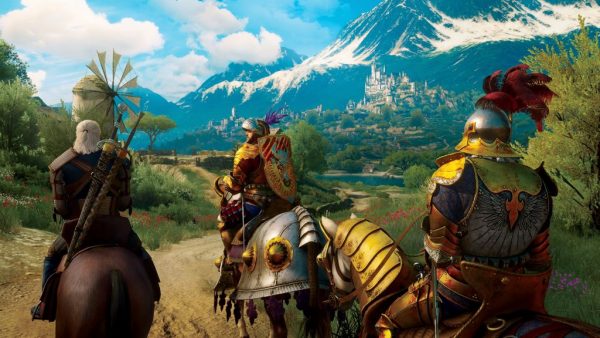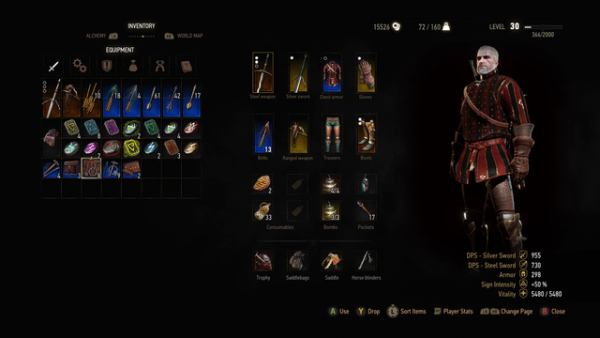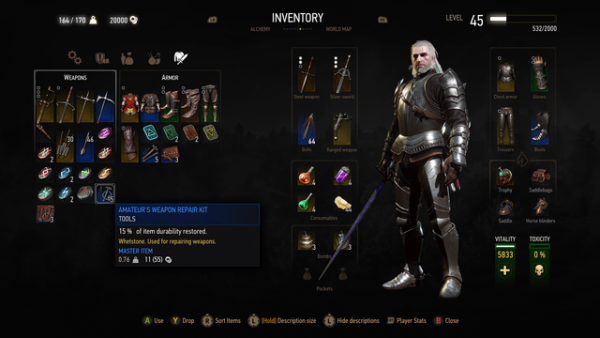Also on: PS4, PC
Publisher: Warner Bros. Interactive
Developer: CD Projekt RED
Medium: Digital
Players: 1
ESRB: M
Back in 2007, CD Projekt RED set foot into the world of video games, and we were introduced to The Witcher — a game built in Bioware’s Aurora engine, which made up for its lacking visuals with strong worldbuilding and a compelling story. We were also introduced to Geralt, an amnesiac who slept around and survived off witcher’s work by hire of simpletons. It’s been a while since then, in what could be considered simpler times of both fiction and reality, and with that span came change for the industry, its audiences, and the responsibility of handling the denouement of one of the most acclaimed franchises to date.
So here we are in the second of two expansions for The Witcher 3, witnessing CD Projekt Red’s farewell to a world that made them who they are now, with a final sendoff for Geralt’s story. If it seems bittersweet, then we’re comfortably set in the world of The Witcher 3: Blood and Wine.

Unlike Hearts of Stone, the Blood and Wine expansion takes place in an entirely new location separate from the map of The Witcher 3’s base game. Players will find themselves in Touissant, a colorful, brightly lit land that blends a variety of French and Italian characteristics to create a distinctly European wine country, with high castle on yonder horizon to boot. By order of royal decree of a duchess, Geralt has been hired for witcher work regarding a mysterious “Beast of Beauclaire” and the recent mutilations it’s produced. There’s not much more to discuss, as far as plot is concerned, as the expansion is story-rich and worth seeing for yourself.
It is worth noting, however, that should Blood and Wine be compared to Hearts of Stone, they size up to each other in different regards. Hearts of Stone didn’t change much in the game, but had some of the series’ best writing in its main story, whereas Blood and Wine is less focused for plot and offers much more in the gameplay and scenery department. That’s not to say that Blood and Wine is lacking, but Hearts of Stone was a tough act to follow, and the main quest for Blood and Wine can’t seem to get off the ground until some time after a big turning point. By then, you’re a dozen or so hours in and finding other things to appreciate — much like the few lulls in The Witcher 3’s lengthy main quest.

Let’s talk more about Touissant. It’s huge; about the size of Velen on the Witcher 3 map, and with lots to do and see. Players will encounter a variety of new enemies and creatures, along with additions to equipment and even a place to call home. Yep, real estate. It’s a low-maintenance affair, but Geralt is awarded a property, “Corvo Bianco,” with a home which can be decorated, and even renovated to accommodate the sort of things that witchers like — such as stables for Roach, or a grindstone, or herb garden. Ever needed to buff the armor you just pulled from your stash, but don’t want to fast travel across the map? Now there’s a central location for all that, along with additional bonuses Geralt can apply by doing things like sleeping in his own bed. It’s one of those things we never thought we needed, but now that it’s around, returning to Corvo Bianco before shutting down the game is one of the more comforting additions to the series. I only wish there was an option to save when going to sleep, but instead watch frustratingly as Geralt simply sits on the edge of his bed and chooses a set time to meditate.
Geralt’s skill tree sees some enhancement, as well, with the introduction of new mutations. These apply a significant buff to either strength, potion, or spells, which breathes new life into a stagnant skill tree. Compared to the runemaster in Hearts of Stone, this secondary tree is a more focused addition to expanding how Geralt plays in battle, allowing players to more freely adapt to situations as needed, whereas runes provided equipment buffs so incremental that they were nearly inconsequential.
Along with the sights are sounds, introducing new musical themes and instruments — perhaps the debut of accordions in the Witcher soundtrack, as well. I should only thank Nintendo for making it confusing to hear such an instrument outside of a Mario or Animal Crossing game. Aside from personal associations, the new score deserves to be commended for adding a gorgeous layer of identity to Touissant — it’s lovely.
It’s also worth noting that (and this is a free patch for all players, regardless of owning the expansion) that CD Projekt RED totally revamped the UI for all panels, bringing menus into the modern age for Witcher 3. Coinciding with the release of Blood and Wine, it feels a little bit like a feature of the DLC, but totally isn’t, and is a total upgrade.


Speaking of hangups, it’s possible that I struggled to settle into Blood and Wine all on my own. While I came in with no real expectations, Touissant is a departure from the apathetic and grounded Witcher universe we know. It’s sunny and bright, rather than the north’s subdued palette, with the romantic setting of Touissant reminding me first of California’s Napa Valley rather than Bordeaux, despite the obviousness of a European city. Even Geralt himself seems a little out of sorts as a character, and seeing him as a homeowner in a foreign land feels odd.
In feeling displaced, it’s easy to see issues more clearly. Primarily for Blood and Wine, is that the writers didn’t seem to know exactly how to lead up to the main quest’s payoff — especially as a turning point for Geralt, and doubly so when Hearts of Stone left us on a much more natural note for calling it off with being a witcher. It’s not like Geralt hasn’t been on the verge of quitting his job since The Witcher 2, but trying to write a story that doubles back on this sentiment forces the main quest into becoming a means to an end — despite a strongly envisioned finish line. Despite a new cast of characters, it feels like there’s nothing to hold on to until the last few hours.
This herding of story beats causes characters to be on emotional roulette for the conceit of plot, leaving players feeling out of the loop. That could be expected in a typical Witcher quest, but in this case, even Geralt seems to be in on the act.
This lead to eventualities, such as how in the ending I achieved, I felt a disconnect with the emotional state of characters against mine. Geralt has never been one to empathize with royalty, and that’s always been one of his best qualities. He’s a complex character who’s not perfect, and it’s believable when Geralt makes mistakes — he gets sarcastic with contractors, stands up for himself . No matter what the outcome, we can always feel like we’re on his side, “Yeah, sorry about the house fire, but the monster’s dead. Pay me so I can get on my way.” Blood and Wine finds Geralt less cavalier and snarky, and almost more depressed and worn out.

Despite how I felt my specific ending played out, CD Projekt RED seems to know exactly where players will be in the final moments of Blood and Wine, or maybe it’s where the studio finds itself — reflective and nostalgic. By the end, it’s easy to level with Blood and Wine’s final bow.
I’m remiss to find myself focusing on the negatives of Blood and Wine, but as it tends to be, the negative aspects seem to require more explanation than the highlights. It may be an urge to resist gushing about the same things that The Witcher has always been great at, as well, or the continued presence of what we love doing in The Witcher 3. Trust me, it’s all there; all the good stuff. If the only thing I can be bothered to go on about is a story that didn’t work for me personally, then that’s saying a lot about what we’ve been given with Blood and Wine. There’s honestly a 30+ hour expansion with a great deal to do aside from the main quest, and if you dig The Witcher, you already know it’s worth jumping into.
And if you can’t let go of The Witcher, it now comes with New Game + mode.
On a more personal note, I’ve enjoyed The Witcher games immensely since being harangued into playing them sometime in 2009. What CD Projekt RED has done for fans of the series has only made each release sequentially and retroactively more dear to me, for both the studio’s efforts and integrity. It may be a bit misguided in this review, but I’d like to say thanks to everyone at CDPR for their work on this series. Everyone there is doing an incredible job.

